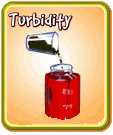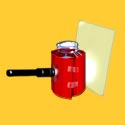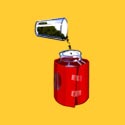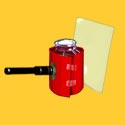Languages

Contributed By: www.jason.org
|
| Share This Experiment |
 |
 |
 |
 |
Experiment Category:
Objective:
Measure turbidity, or the amount of sediment suspended in water, and learn how turbidity affects aquatic life.
What You Need:
- 2 sheets of black construction paper
- 1 sheet of white paper
- Tape
- Large, clear glass jar
- Empty soda can or jar lid
- Flashlight
- Dirt
- Water
To Do and Observe:
1) Line up two pieces of black construction paper and trace a circle in the center using the empty soda can.2) Cut out the circles.3) Tape the two pieces of construction paper around the glass jar so that the two holes are opposite each other. You might have to trim the construction paper so your pieces fit the jar. Make sure that: a) there are no gaps between your pieces that will let light through, and b) the second circle is on the opposite side of the jar from the first circle.4) Fill the jar three-quarters full with tap water.5) Using the flashlight, shine the beam of light through the holes in the side of the jar. On the opposite side of the jar, hold up a sheet of white paper about one inch from the holes.6) Record the level of light intensity (low, medium, high).7) Slowly add measured amounts of dirt to the water and monitor the change in light intensity.
What's Going On:
As you add more dirt to your jar, you increase the turbidity of water, and less light is able to shine through. Turbid water might be described as murky. The clearer the water, the lower its turbidity. When turbidity is high, solid particles, such as sediment suspended in water, can block the light aquatic plants and organisms need to survive. They can clog the gills of fish. Suspended solids can also absorb heat from sunlight, raising the temperature of the water. As the water warms, it loses its ability to hold oxygen. This causes dissolved oxygen levels to drop, further reducing the number of plants and animals that can live in the water.
Parent/Teacher Tips:
Take your children to visit a pond or lake to observe the clarity of natural bodies of water. After a heavy rain, you may notice an increase in the turbidity of the water. Visit the same spot the following day and observe the dramatic difference.
